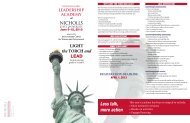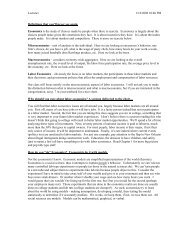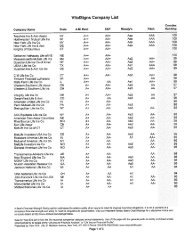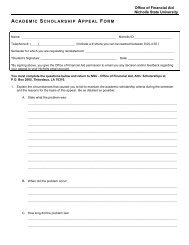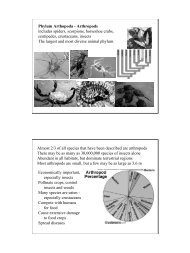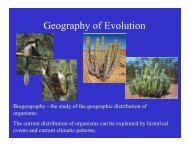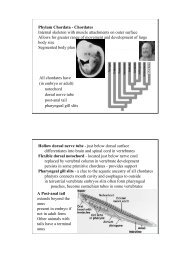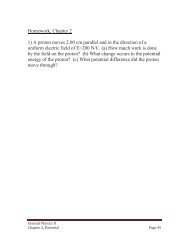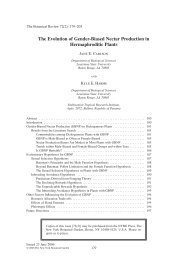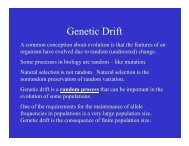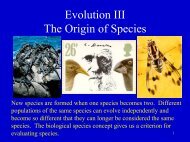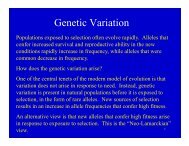Animal Diversity 2.pdf
Animal Diversity 2.pdf
Animal Diversity 2.pdf
Create successful ePaper yourself
Turn your PDF publications into a flip-book with our unique Google optimized e-Paper software.
Phylum Platyhelminthes - Flatworms<br />
Dorsoventrally flattened bodies<br />
well defined head<br />
Bodies are solid (acoelomate)<br />
gut is the only internal cavity<br />
Ribbon-shaped, soft-bodied<br />
Many species are parasitic<br />
some are free-living carnivores or<br />
scavengers<br />
Move via ciliated epithelial cells on<br />
lower surface and waves of<br />
contractions of body muscles
Organs<br />
digestive system is branched with a single opening<br />
pharynx can be extended/retracted<br />
internal enzymatic digestion, diverticula distribute food<br />
Eye spots - cells in<br />
light sensitive cups<br />
Simple nervous<br />
system with 2<br />
ventral nerve<br />
cords, simple brain<br />
Free living forms<br />
possess chemical<br />
sensory systems on<br />
lobes of head
Reproduction<br />
Most are hermaphroditic with internal fertilization and separate<br />
ovaries and testes<br />
fertilized eggs deposited in cocoons, hatch into miniature adults<br />
Can reproduce asexually by fragmentation and regeneration<br />
No circulatory system, food and oxygen diffuse to tissues<br />
Excretory system is simple -<br />
“flame cells” propel fluids<br />
through tubules to outside of<br />
body - primarily for ridding<br />
body of excess water
Three classes of flatworms<br />
Class Turbellaria - free-living flatworms<br />
Class Trematoda - flukes<br />
Class Cestoda - tapeworms
Class Turbellaria - Turbellarians, free-living flatworms<br />
predators on smaller organisms, and scavengers<br />
found in water and moist habitats<br />
Dugesia, the common planarian
Class Trematoda - Flukes<br />
Parasites on other animals<br />
Name originates from their shape<br />
Lack sensory and locomotive adaptations of<br />
free-living forms<br />
feed on host tissue, food taken in through<br />
mouth, resistant to host defenses<br />
Complex life cycles
Example: Clonorchis, human liver fluke - Adults live in<br />
association with liver - Eggs passed in feces - Ingested by snail -<br />
transform into swimming larva that leaves snail - Nonciliated<br />
redia give rise to cercariae - Bore into fish, encyst in muscle -<br />
Humans eat uncooked fish, flukes migrate to liver
Example: Schistosoma blood flukes<br />
Causes disease: schistosomiasis<br />
“bilharzia” is spreading through the<br />
tropics
Class Cestoda - Tapeworms<br />
Highly specialized parasites<br />
Adults live in the gut of vertebrates<br />
attached to intestinal wall<br />
Body divided into scolex, neck and<br />
reproductive proglottids (strobila)<br />
Absorb food through outer body wall<br />
Proglottids formed continuously from<br />
region behind scolex at neck<br />
Hermaphroditic with testes and<br />
ovaries in each proglottid<br />
Eggs toward end mature, become<br />
fertilized - may be self-fertilized<br />
Embryos and proglottids leave host<br />
in feces
Example: Taenia saginata,<br />
beef tapeworm - a parasite<br />
of humans
Phylum Nematoda - Roundworms<br />
Include nematodes, eelworms and<br />
roundworms<br />
Abundant in marine, freshwater and<br />
terrestrial habitats - found everywhere<br />
Most are microscopic in size<br />
predators, parasites, and scavengers<br />
Trichinella - the cause of<br />
trichinosis
Pseudocoelomate body plan - No mesoderm associated with the gut<br />
Bilaterally symmetrical, cylindrical, unsegmented, covered by thick<br />
flexible cuticle that is molted periodically<br />
longitudinal muscles located beneath the epidermis, pull against<br />
cuticle and water filled pseudocoel - Results in side-to-side<br />
whipping movement - move well through loose soil or tissues<br />
Digestive system<br />
with piercing stylets,<br />
mouth, pharynx,<br />
intestine, and anus<br />
Sexual reproduction<br />
usually separate<br />
sexes and internal<br />
fertilization,<br />
fertilized eggs laid
Many nematodes parasitize humans - Ascaris, hookworms, pinworms<br />
Example: Trichinella - pig intestinal roundworm<br />
Worm lives in small intestine of pig, young encyst in same host<br />
Trichinosis can result if humans eat raw or undercooked pork<br />
Worms may also infect bears



